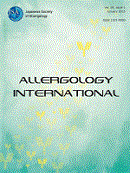Volume 72, Issue 1
Displaying 1-24 of 24 articles from this issue
- |<
- <
- 1
- >
- >|
Editorial
-
2023Volume 72Issue 1 Pages 1-2
Published: 2023
Released on J-STAGE: February 04, 2023
Download PDF (429K)
Invited Review Articles
Review Series: Rapid Progress in Molecular Targeted Therapy for Allergic Diseases
-
2023Volume 72Issue 1 Pages 3-10
Published: 2023
Released on J-STAGE: February 04, 2023
Download PDF (896K) -
2023Volume 72Issue 1 Pages 11-23
Published: 2023
Released on J-STAGE: February 04, 2023
Download PDF (725K) -
2023Volume 72Issue 1 Pages 24-30
Published: 2023
Released on J-STAGE: February 04, 2023
Download PDF (490K) -
2023Volume 72Issue 1 Pages 31-40
Published: 2023
Released on J-STAGE: February 04, 2023
Download PDF (515K)
Invited Review Article
-
2023Volume 72Issue 1 Pages 41-53
Published: 2023
Released on J-STAGE: February 04, 2023
Download PDF (1638K)
Review Article
-
2023Volume 72Issue 1 Pages 54-62
Published: 2023
Released on J-STAGE: February 04, 2023
Download PDF (881K)
Original Articles
-
2023Volume 72Issue 1 Pages 63-74
Published: 2023
Released on J-STAGE: February 04, 2023
Download PDF (967K) -
2023Volume 72Issue 1 Pages 75-81
Published: 2023
Released on J-STAGE: February 04, 2023
Download PDF (1136K) -
2023Volume 72Issue 1 Pages 82-88
Published: 2023
Released on J-STAGE: February 04, 2023
Download PDF (883K) -
2023Volume 72Issue 1 Pages 89-99
Published: 2023
Released on J-STAGE: February 04, 2023
Download PDF (1976K) -
2023Volume 72Issue 1 Pages 100-106
Published: 2023
Released on J-STAGE: February 04, 2023
Download PDF (950K) -
2023Volume 72Issue 1 Pages 107-115
Published: 2023
Released on J-STAGE: February 04, 2023
Download PDF (328K) -
2023Volume 72Issue 1 Pages 116-127
Published: 2023
Released on J-STAGE: February 04, 2023
Download PDF (895K) -
2023Volume 72Issue 1 Pages 128-134
Published: 2023
Released on J-STAGE: February 04, 2023
Download PDF (1132K) -
2023Volume 72Issue 1 Pages 135-142
Published: 2023
Released on J-STAGE: February 04, 2023
Download PDF (2491K) -
2023Volume 72Issue 1 Pages 143-150
Published: 2023
Released on J-STAGE: February 04, 2023
Download PDF (1367K) -
2023Volume 72Issue 1 Pages 151-160
Published: 2023
Released on J-STAGE: February 04, 2023
Download PDF (2390K) -
2023Volume 72Issue 1 Pages 161-168
Published: 2023
Released on J-STAGE: February 04, 2023
Download PDF (1837K)
Letters to the Editor
-
2023Volume 72Issue 1 Pages 169-172
Published: 2023
Released on J-STAGE: February 04, 2023
Download PDF (416K) -
2023Volume 72Issue 1 Pages 173-175
Published: 2023
Released on J-STAGE: February 04, 2023
Download PDF (317K) -
2023Volume 72Issue 1 Pages 176-178
Published: 2023
Released on J-STAGE: February 04, 2023
Download PDF (1096K) -
2023Volume 72Issue 1 Pages 179-181
Published: 2023
Released on J-STAGE: February 04, 2023
Download PDF (796K) -
2023Volume 72Issue 1 Pages 182-184
Published: 2023
Released on J-STAGE: February 04, 2023
Download PDF (960K)
- |<
- <
- 1
- >
- >|
